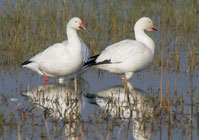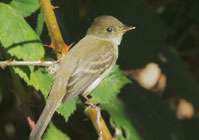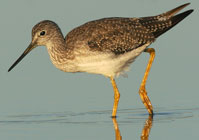Accomplishments
The CVJV partnership has earned an impressive record of accomplishment since its inception in 1988, and is making great progress towards meeting the objectives identified in its 2020 Implementation Plan.

 Willow Flycatcher
Willow FlycatcherThe Central Valley Joint Venture has its origins in the North American Waterfowl Management Plan (NAWMP), an international treaty signed in 1986 by Canada, the United States and Mexico. Although the goals of the NAWMP were continental in scope, the plan’s success depended on regional efforts to increase waterfowl habitat. The joint venture concept of merging the efforts of government agencies, non-profit organizations, corporations, tribes, and individuals was ideally suited to the task of meeting waterfowl needs at a regional scale. As a result, joint ventures were eventually formed in all of North America’s key waterfowl areas to meet NAWMP goals.
The Central Valley Habitat Joint Venture was formally organized in 1988 and was one of the original six priority joint ventures formed under the NAWMP. The founding members of the first Management Board included the California Waterfowl Association, Defenders of Wildlife, Ducks Unlimited, National Audubon Society, the Nature Conservancy, Waterfowl Habitat Owners Alliance, California Department of Fish and Game, The Trust for Public Land, and the U.S. Fish and Wildlife Service. Renamed the Central Valley Joint Venture in 2004, the Management Board now enjoys the membership of twenty Federal and State agencies and conservation organizations.
Over its 20-year history, the Central Valley Joint Venture has achieved an impressive record of success. Partnership, collaboration and commitment define the approach of the organizations and individuals that work to implement its conservation objectives. During the coming year we will bring you the stories of some of the individuals, organizations and partnerships that have done so much on behalf of wildlife and the public.
The CVJV partnership has earned an impressive record of accomplishment since its inception in 1988, and is making great progress towards meeting the objectives identified in its 2020 Implementation Plan.

Follow these links to learn about some of the important bird conservation work happening in California's Central Valley.
